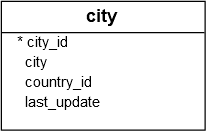August 3, 2023
Summary: in this tutorial, you will learn how to use the PostgreSQL NATURAL JOIN to query data from two or more tables.
Table of Contents
Introduction to the PostgreSQL NATURAL JOIN
A natural join is a join that creates an implicit join based on the same column names in the joined tables.
The following shows the syntax of the PostgreSQL natural join:
SELECT select_list
FROM T1
NATURAL [INNER, LEFT, RIGHT] JOIN T2;
A natural join can be an inner join, left join, or right join. If you do not specify a join explicitly e.g., INNER JOIN, LEFT JOIN, RIGHT JOIN, PostgreSQL will use the INNER JOIN by default.
If you use the asterisk (*) in the select list, the result will contain the following columns:
- All the common columns, which are the columns from both tables that have the same name.
- Every column from both tables, which is not a common column.
PostgreSQL NATURAL JOIN examples
To demonstrate the PostgreSQL natural join, we will create two tables: categories and products.
The following CREATE TABLE statements create the categories and products tables.
DROP TABLE IF EXISTS categories;
CREATE TABLE categories (
category_id serial PRIMARY KEY,
category_name VARCHAR (255) NOT NULL
);
DROP TABLE IF EXISTS products;
CREATE TABLE products (
product_id serial PRIMARY KEY,
product_name VARCHAR (255) NOT NULL,
category_id INT NOT NULL,
FOREIGN KEY (category_id) REFERENCES categories (category_id)
);
Each category has zero or many products and each product belongs to one and only one category.
The category_id column in the products table is the foreign key that references to the primary key of the categories table. The category_id is the common column that we will use to perform the natural join.
The following INSERT statements insert some data into the categories and products tables.
INSERT INTO categories (category_name)
VALUES
('Smart Phone'),
('Laptop'),
('Tablet');
INSERT INTO products (product_name, category_id)
VALUES
('iPhone', 1),
('Samsung Galaxy', 1),
('HP Elite', 2),
('Lenovo Thinkpad', 2),
('iPad', 3),
('Kindle Fire', 3);
The following statement uses the NATURAL JOIN clause to join the products table with the categories table:
SELECT * FROM products
NATURAL JOIN categories;

The above statement is equivalent to the following statement that uses the INNER JOIN clause.
SELECT * FROM products
INNER JOIN categories USING (category_id);
The convenience of the NATURAL JOIN is that it does not require you to specify the join clause because it uses an implicit join clause based on the common column.
However, you should avoid using the NATURAL JOIN whenever possible because sometimes it may cause an unexpected result.
For example, See the following city and country tables from the sample database:


Both tables have the same country_id column so you can use the NATURAL JOIN to join these tables as follows:
SELECT *
FROM city
NATURAL JOIN country;
The query returns an empty result set.
The reason is that…
Both tables also have another common column called last_update, which cannot be used for the join. However, the NATURAL JOIN clause just uses the last_update column.
In this tutorial, you have learned about the PostgreSQL NATURAL JOIN works and how to use it to query data from two or more tables that have the common columns.

